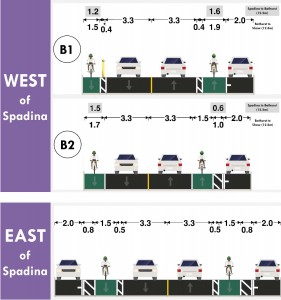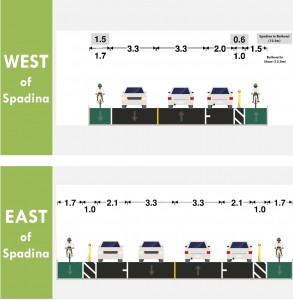Design options released for tentative Bloor Street project
By Marielle Torrefranca
The City of Toronto has released a series of bike lane designs for its proposed pilot project on Bloor Street between Shaw Street and Avenue Road.
There are three main options: the removal of all on-street parking on Bloor Street for bike lanes (this design was not carried forward due to lack of parking and loading); buffered bike lanes between curbside parking and traffic lanes; and curbside bike lanes protected by buffers or bollards. The latter two options both retain car parking on one side of the street or the other.

Option B, version 1: Bicycle lanes are separated from the roadway by
narrow buffers in both directions. Buffers can consist of bollards in one direction where feasible. However, as there is no buffer between the bike lane and on-street parking, cyclists would have to watch for opening
vehicle doors, and vehicles merging into traffic or exiting traffic.
Option B, version 2: Bicycle lanes in both directions with a buffer between cyclists and parked motor vehicles. This allows for room between cyclists and open vehicle doors. East of Spadina Road: Larger road east of Spadina Road allow for buffered bike lanes in both directions, buffered from both traffic lanes and motor vehicle door zones. Courtesy City of Toronto
The designs include optional variations, as the roadways differ along the corridor. For instance, the roadways are larger by about three metres in width east of Spadina Road. Other constraints include limited roadway space and competing uses, reduced parking, and possible motor vehicle traffic delay. The designs are available on the city’s website and open to feedback from the public until Jan. 15.

Option C: Bicycle lanes are separated from the roadway by motor vehicle
parking. One parking lane could be on the same side of the street
for the entire corridor or alternate between both sides of the street.
The door zone would be buffered, with bollards where feasible. East of
Spadina Road, bike lanes in both directions would be separated from
the roadway, with buffers in the door zone. Courtesy City of Toronto
The city’s goal is to choose the safest option that is still harmonious with surrounding businesses and motor vehicles.
“Seventy-three per cent of Torontonians say lack of cycling infrastructure is holding them back from riding more often,” said Jared Kolb, executive director of Cycle Toronto, one of the stakeholders of the project.
Currently, there are no dedicated bicycle lanes on Bloor Street.
“Ultimately our number one priority is creating a safe connected network in Toronto, and Bloor Street can be a real backbone,” said Kolb.
“I don’t ride on Bloor [Street]. It’s too dangerous,” said cyclist Dave Cronsilver, who has had his fair share of collisions with motor vehicles. Although the avid cyclist is nursing an injured arm from his most recent tangle, he said he is still keen to get back on his two wheels — if it were safer.
Staff Sergeant James Hogan is the manager of the community response unit for Toronto Police Division 14, where he also runs the bike crew. After cycling downtown for more than 20 years, he said bike traffic is changing on Bloor Street.
“From my observation, it’s a challenge for cyclists and motorists to coexist there,” said Hogan. “Like other streets, there seems to be more and more cycling activity, and I certainly see that where there’s almost bike traffic jams.”
Hogan said the chosen bike lane design should aim to provide better safety, clarity, and continuity.
“It’s just not clear what the best and safest place for the cyclist to be is,” he added.
The pilot project, still subject to council approval, has been more than 20 years in the making. City council has been commissioning studies on Bloor Street bike lanes since 1992.
Kolb said he hopes there’s enough of a critical mass to give the proposal an extra push this time around, as they’ve been working to create a stronger community voice through local residents, schools, and businesses. And, the David Suzuki Foundation has also recently become involved.
As the trial may result in a 50 per cent reduction in parking along Bloor Street, the Bloor-Annex and Korea Town business improvement areas (BIAs) are looking to measure the economic impact of the bike lanes on their members. New bike lanes can especially have an impact on parking and loading for businesses.
The University of Toronto, in partnership with the Toronto Centre for Active Transportation, is conducting an economic study on what impact, if any, bike lanes on Bloor Street will have on the area’s businesses. Research began in October and will cost $22,500. The BIAs and the Metcalf Foundation have contributed to the funding.
As for next steps, the city will pick a design option this winter and develop detailed design and costs. In the spring, a second public consultation event will be held, accompanied with another online survey. Should council approve the pilot project proposal in the spring, the bike lanes could be installed by the summer.
Upon approval, of course.
